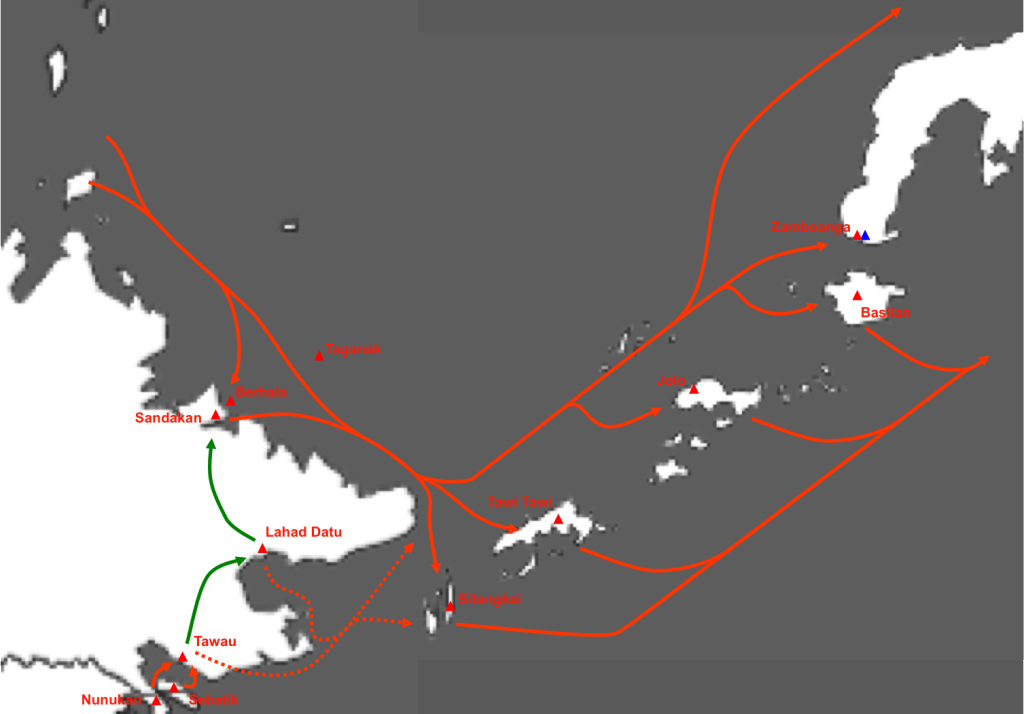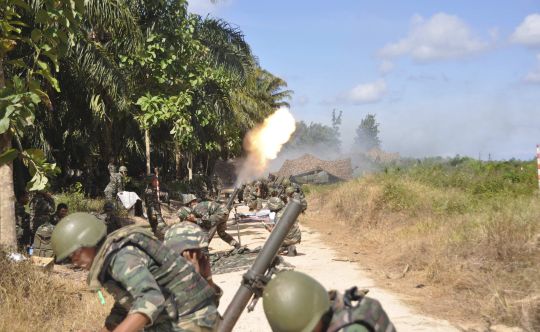In March 2013 a Malaysian Air Force F-18 initiated an assault on a tiny East Malaysian village near the city of Lahad Datu. Its target was the final stronghold of the Royal Sulu Army, armed henchmen loyal to the Sultanate of Sulu, a defunct political entity that at one time spanned the borders of the modern Philippines and Malaysia. In the smoking aftermath of the final battle with the group, 80 people lay dead (including 10 Malaysian soldiers and policemen), over 700 were in custody, and police confiscated a surprising assortment of powerful weapons and ammunition.
Portrayed as misguided terrorists by Malaysian leaders, the ethnic Tausug invaders that confounded Malaysian authorities for over a month armed themselves with assault rifles and ammunition from an illicit arms market that thrives in the poorly controlled border areas of Malaysia, the Philippines, and Indonesia. Although Malaysia dealt decisively with the Royal Sulu Army in 2013, the arms market that supplied them is part of the history and culture of the area and remains a security problem for at least five member states of the Association of Southeast Asian Nations (ASEAN).
The Sulu Arms Market, described in the 2011 book by the same name, is not a market in the physical sense, rather it is an economy of guns where firearms and ammunition are the currency of a thriving international trade in violence. Its 500-year history of competition and conflict is older than most, yet the Sulu Arms Market is quite common in that it is both a source and a destination for smuggled guns. Due to the richness and politically fractured characteristics of the tri-border area, the Sulu Arms Market is intertwined with piracy, terrorism, and the traffic of other illicit commodities. At various points since the Spanish conquest of the Philippines in 1521, European colonialists, Moro (Philippine Muslim) independence groups, Communists, Islamic militants, and criminal gangs all played a major part in the market’s development making it a truly globalized enterprise.

The Players
While the Sulu Arms Market has its origins in colonial struggles between Spain, England, Germany, and the Netherlands its modern foundation was established in the political chaos of Southeast Asia following the Second World War. Communist guerillas across Southeast Asia, trained and equipped by the Allies during the War, turned against their post-war governments and became the primary recipients of arms shipments from abroad. As the Cold War set in, these groups drew direct support from communist China, the Soviet Union, and eventually Vietnam and North Korea. Added to the massive volume of guns remaining from the fighting in the Philippines, this Communist supply spilled over to similar movements throughout Asia including the Khmer Rouge, the Pathet Lao, the communist parties of Indonesia and Thailand, as well as Nepalese and Indian groups.
The Moros also rearmed after the Second World War. Organized initially as a secular nationalist movement, the Moro National Liberation Front (MNLF) waged guerilla warfare against Manila for control of historically Muslim southern islands. Led by an ethnically Tausug leftist agitator and Sulu nationalist named Nur Misuari, the MNLF received political support and clandestine logistics (including arms) from Malaysia.[1] It was not long before Misuari developed direct ties with a number of powerful external sponsors, including Libya’s Muammar Ghadaffi and Pakistan’s president Yahya Khan, both of whom sponsored Islamic causes around the world. MNLF’s secular approach began to fall apart however in the 1980s when a number of its officers established a religiously inspired splinter group: the Moro Islamic Liberation Front (MILF).
The MILF brought jihad to the southern Philippines and with it, Islamist arms sources. Powerful new sponsors, inflated by victory over the Soviets, found the religious MILF more worthy of support than the secular MNLF. As Misuari and the MNLF pursued a secular agenda in peace talks with Manila, jihadi suppliers like Al Qaeda shifted their support (mostly in arms and training) to the MILF and Abu Sayyaf Group, another Islamist Moro faction. The MILF’s connection to these jihadi groups was critical to finance the import of weapons from Sabah during the 1990s. Guns poured into Mindanao from every corner of the globe via well-known smuggling routes through the Sulu archipelago. In 1992, the scale of black arms shipments to the Moros attracted suppliers from Afghanistan, Colombia, China, Pakistan, Cambodia, Palestine, Lebanon, Sudan, Libya, North Korea, Thailand, Saudi Arabia and Malaysia (Sabah); with transit points in Singapore, Indonesia, Taiwan, Hong Kong, Vietnam, and Myanmar. As a result of this influx of weapons, the MILF was secure enough to continue fighting independently when Misuari’s MNLF reached a peace agreement with Manila in 1996. With as many as 12,000 men under arms, the MILF sat atop an enormous black arms trade and controlled roughly 10 per cent of Mindanao and large parts of the Sulu archipelago. Control of this territory allowed large arms shipments to become routine and with violence at a low ebb, the Sulu Arms Market once again became a source of guns for the rest of Asia.

Sensing opportunity, Asia’s criminals soon became significant players in the Sulu Arms Market. At the lowest end of the scale are the “ant traders”; Sulu or Sabah natives that benefit from access to both sides of the border. Their opportunistic, few-guns-at-a-time operations thrive in border areas where one country has a legal market and the other does not. As a result, ant trading accounts for much of the arms and ammunition transiting between the Philippines, Malaysia and Indonesia.
At the other end of the scale are transnational organized crime gangs from Japan, China, and Taiwan. Strict and well-enforced gun laws in northeast Asia make high quality handcrafted Filipino counterfeits called paltiks very popular among these gangsters. In an effort to control this dangerous cottage industry, the Philippine government created licensed manufacturers in Cebu with the idea of luring paltik craftsmen into legitimate employment in state factories. Not surprisingly, this move created ideal conditions for parts-smuggling that feeds the very paltik industry it was designed to destroy.
The criminality of arms trading is less clear when it involves wealthy and influential Filipinos. They are primarily arms consumers, stockpiling enormous arsenals that offer them increased prestige and protects them from weak gun laws. When these politicians and businessmen also identify themselves as either leftist, Moro or Christian, the lines between criminality, politics, and terrorism become extremely blurred as we saw in the case of the Maguindanao Massacre in 2009.
Sulu as a Source
The rise and fall of the Royal Sulu Army demonstrates that the Sulu Arms Market is real. It persists despite a multitude of countermeasures against it by governments both in and out of the region. It is a security problem of unmeasured proportions and its deadly products flow increasingly outward as violence reaches a low ebb. Moro weapons have made their way into the hands of separatists and militias in Papua New Guinea, Irian Jaya, East Timor, and the Malukus. But insurgent guns are not the only ones supplying the demand. Legally produced rifles, ammunition, and machine guns also end up in the black market through intentional overproduction, diversion, theft or loss. Known paltik manufacturing operations in Malaysia, Indonesia, and the Philippines reinforce the supply from legal sources. Lastly, leakage from regional military and police sources is famously commonplace. Pilferage of stocks of obsolete weaponry continues to occur as both the Philippines and Malaysia replaced their standard infantry rifles with 45,000 M-16 rifles from the United States in 2009.
It is not hard to imagine that as violence reaches historic lows in Mindanao due to MILF-Manila peace efforts, cash-strapped armorers in those countries will ignore the long-term profit potential of black arms exports. If the governments of the region fail to keep a close eye on the Sulu Arms Market (or perhaps even if they do), peace in Mindanao could come at the cost of the southern Philippines evolving once again into a for-profit illicit gun store for Asia.
[1] Though Nur Misuari served Kuala Lumpur’s interests in 1969, he was widely seen as provoking the Royal Sulu Army’s invasion of Sabah in 2013.
Lino Miani is a retired US Army Special Forces officer, author of The Sulu Arms Market, and CEO of Navisio Global LLC.


One thought on “The Sulu Arms Market: Globalized Gunrunning Since 1521”
Comments are closed.